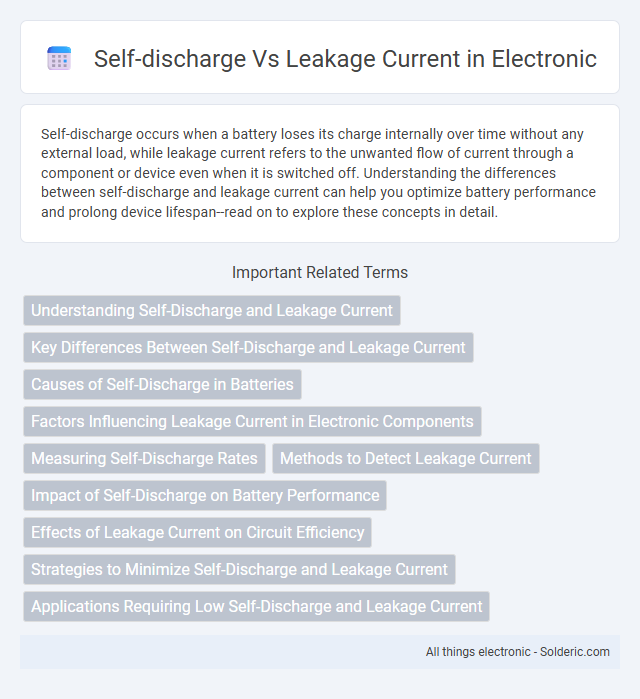Self-discharge occurs when a battery loses its charge internally over time without any external load, while leakage current refers to the unwanted flow of current through a component or device even when it is switched off. Understanding the differences between self-discharge and leakage current can help you optimize battery performance and prolong device lifespan--read on to explore these concepts in detail.
Comparison Table
| Aspect | Self-Discharge | Leakage Current |
|---|---|---|
| Definition | Natural loss of battery charge over time without any external load. | Unwanted current flow through an insulating material or device when voltage is applied. |
| Cause | Internal chemical reactions inside a battery or capacitor. | Imperfections, contamination, or degradation in insulating materials or circuitry. |
| Measurement Unit | Percentage of capacity lost per month or year (%) | Amperes (A) or microamperes (uA) |
| Effect | Reduces stored energy, shortens device standby time. | Increases power consumption and potential device malfunction. |
| Typical Application | Batteries, capacitors, energy storage devices. | Electronic components, semiconductors, insulation systems. |
| Mitigation | Improved battery chemistry, better storage conditions. | Use high-quality insulators, minimize contamination, proper circuit design. |
Understanding Self-Discharge and Leakage Current
Self-discharge refers to the natural loss of charge in a battery when it is not connected to a load, caused by internal chemical reactions that reduce its stored energy over time. Leakage current, on the other hand, is the unintended flow of current through insulation or circuit components, leading to continuous power drain even when the device is off. Understanding these phenomena helps you optimize battery life by minimizing energy losses in both inactive and standby states.
Key Differences Between Self-Discharge and Leakage Current
Self-discharge is an inherent characteristic of batteries, causing them to lose charge over time even when not connected to a load, whereas leakage current refers to the small, unwanted flow of current through insulating materials or circuitry when powered. Self-discharge rates vary depending on battery chemistry and environmental conditions, significantly impacting battery shelf life, while leakage current affects device efficiency and safety by causing energy loss and potential component damage. Understanding the distinction between self-discharge and leakage current helps optimize battery management and electronic device performance for your applications.
Causes of Self-Discharge in Batteries
Self-discharge in batteries occurs due to internal chemical reactions that naturally deplete stored energy even when the battery is not in use. Impurities in the electrode materials and electrolyte facilitate these reactions, accelerating the rate of self-discharge. Understanding these causes helps you manage battery storage conditions to minimize capacity loss over time.
Factors Influencing Leakage Current in Electronic Components
Leakage current in electronic components is influenced by factors such as material properties, temperature, and manufacturing defects. High dielectric constant materials and thinner insulation layers typically increase leakage current, while elevated temperatures accelerate charge carrier mobility, further exacerbating leakage. Impurities and structural imperfections within semiconductors create unintended conductive paths, significantly impacting device reliability.
Measuring Self-Discharge Rates
Measuring self-discharge rates involves monitoring the gradual loss of charge in a battery when it is not connected to any load, distinguishing this from leakage current, which occurs through external circuits or defects. You can perform tests by fully charging the battery, isolating it, and recording voltage drops over time to assess the inherent self-discharge characteristics. Accurate self-discharge measurements help in predicting battery life and maintaining optimal performance in devices.
Methods to Detect Leakage Current
Detecting leakage current involves using precision instruments like picoammeters and electrometers to measure the tiny currents that escape from a battery or capacitor. Techniques such as the guard ring method help isolate leakage paths, improving measurement accuracy by minimizing external interference. Understanding leakage current detection methods allows you to differentiate it from self-discharge, ensuring better battery performance management.
Impact of Self-Discharge on Battery Performance
Self-discharge significantly reduces battery capacity over time by causing a gradual loss of stored energy even when the battery is not in use, impairing your device's runtime and reliability. This internal energy loss accelerates aging and diminishes battery performance, leading to more frequent recharges and shorter overall lifespan. Managing self-discharge rates is crucial for maintaining optimal battery efficiency and ensuring consistent power delivery in critical applications.
Effects of Leakage Current on Circuit Efficiency
Leakage current in electronic circuits directly reduces overall efficiency by causing continuous power loss even when the circuit is idle, leading to increased energy consumption and heat generation. Unlike self-discharge, which primarily affects battery capacity over time, leakage current diminishes the effective operational performance of your entire circuit by wasting energy. Minimizing leakage current through careful design and component selection is crucial for enhancing device longevity and maintaining optimal circuit efficiency.
Strategies to Minimize Self-Discharge and Leakage Current
To minimize self-discharge and leakage current in batteries, implement advanced electrode materials with low reactivity and optimize electrolyte composition to reduce parasitic reactions. Employ high-quality separators with excellent ionic conductivity and low electronic conductivity to prevent internal short circuits and leakage pathways. You can also enhance battery design through precise manufacturing controls and surface coatings to stabilize interfaces and extend overall battery life.
Applications Requiring Low Self-Discharge and Leakage Current
Applications requiring low self-discharge and leakage current include battery-powered medical devices, precision sensors, and long-term energy storage systems where maintaining charge integrity over extended periods is critical. Low self-discharge rates ensure minimal energy loss during idle times, preserving device lifespan and reliability, while reduced leakage current prevents unnecessary power drain in sensitive electronic components. These factors are essential in wearable health monitors, remote IoT sensors, and backup power supplies, where consistent performance and energy efficiency are paramount.
Self-discharge vs leakage current Infographic

 solderic.com
solderic.com